|
Russia, East-Central Europe,
and Central Asia:
Overview and Economic History
I. Overview of Central Eurasia
A.
Diversities of geography, economy, and culture.
B.
Dominance of Russia—36% of population, 41% of
production, 73% of surface area (Russia's land area is 84%
larger than the United States). Abundant reserves.
C.
Demographic trends—population losses associated
with WWI, Russian revolution, Russian civil war,
collectivization, and WWII. Fastest population growth in
central Asia.
D.
GDP growth—Russian share of regional GDP
declined from about 45 percent in 1940 to 41 percent in 1993.
Most countries experienced slower growth between 1980 and
1993, due to decline of planning, difficulties of transition,
and with regional hostilities.
II.
Beginnings
A.
Early settlements—tribes in Caucasus area before
20,000 B.C. Slavic tribes date to 2,000 B.C. in eastern
Carpathians, spread west to Czech area, east to Russia, south
to Balkans.
B.
Greek realm united after 359 B.C. by Philip
of Macedon, and his son Alexander
conquered most of Persia, spreading Greek culture through an
enormous empire.
C.
Romans conquered Alexander’s western empire and
much of Europe. Empire administratively divided East-West in
285AD. In 313AD, Emperor Constantine declared that
Christianity was the religion of the Roman Empire
The
Roman Empire After 285AD
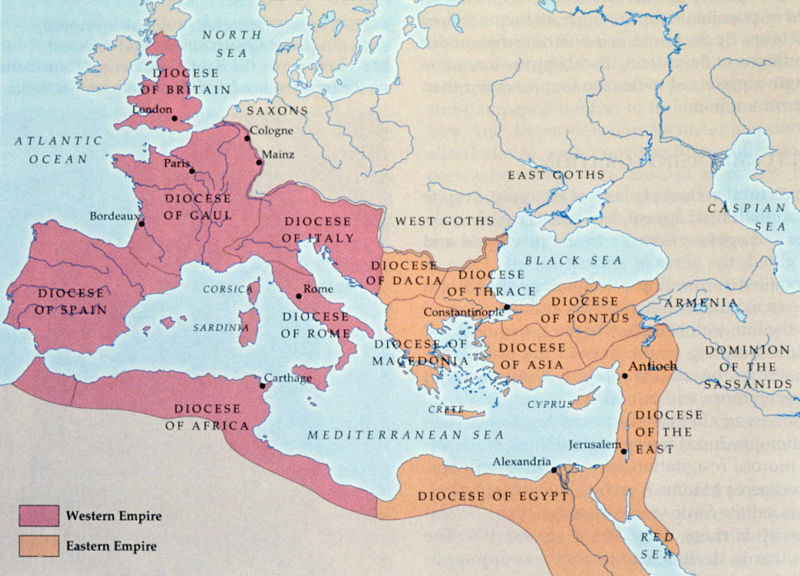
D.
In
476AD, the government and many cultural traditions of the
Western Empire fell to "barbarians," but Christianity survived
as the dominant religion in that region. The
Byzantine empire,
based in Constantinople, preserved classical civilization and
philosophy. However, the Eastern church's adoption of Greek
liturgy and other issues led to the Eastern Schism from Rome
in 1054, followed by a Western Schism from 1378-1417 with
competing Popes in Rome and Avignon, France.
Byzantine Empire in 814

The
Great Schism

E.
Bulgaria—first Slav state in the 6th
century A.D.
F.
Kievan Rus—Located on a trade route between
Scandinavia and the Black Sea, Kiev became capital of Russian
city-states during 9th century. Kievans were cosmopolitan, but
adoption of Eastern Orthodoxy in 980 contributed to Eastern
separation.
Principalities of the Kievan Rus (1054-1132)
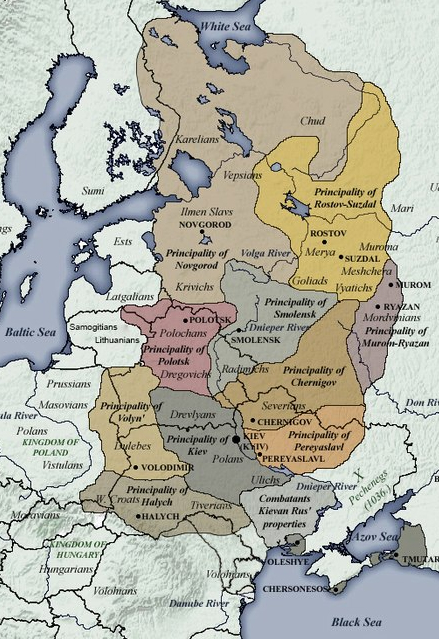
G.
Muslim
conquests after 622 spread Islam into regions that included
Central Asia, and then the Ottoman Empire spread into
southeastern Europe after the fall of Constantinople/Istanbul
in 1453, and dominated the region until the end of World War
I. The Czechs, Slovaks, Poles, and Slovenes avoided Ottoman
domination; Hungary and Croatia were liberated early. Today,
these have higher per capita incomes.
The
Spread of Islam, 622-750

Meanwhile
the Mongol conquest in 13th-15th
centuries devastated Central Eurasia, severed Western ties,
and caused Russian capital to move to Moscow, which became the
“Third Rome” after the fall of Constantinople.
The
Mongol Empire

The Ottoman Turks defeated the Byzantine Empire in 1453 with
the conquest of Constantinople, and ruled over a large area in
Southeastern Europe, including Greece, former Yugoslavia, and
Romania until the end of World War I.
The
Ottoman Empire, 1798-1923
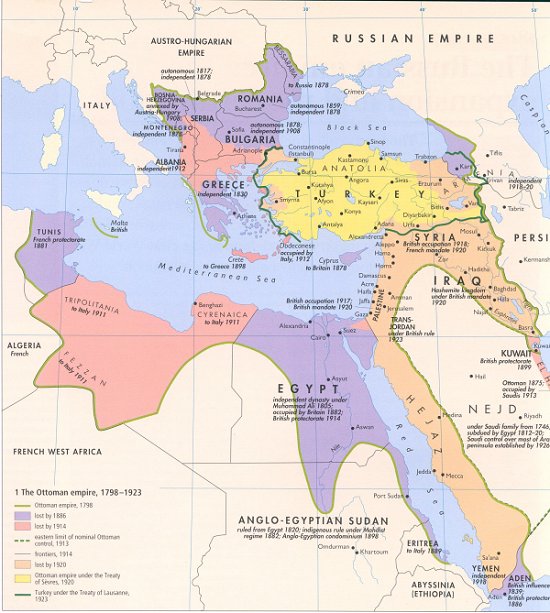
III.
Peter the Great and Russian Expansion (18th-19th
Centuries)
A.
After Russian independence from Mongols in 1452, isolationism
and feudal institutions.
B.
Early in 18th century, Peter the Great:
1.
Introduced Western science, technology, art, and architecture.
2.
Moved capital to St. Petersburg.
3.
Avoided Western political and economic philosophies.
4.
Levied heavy taxes and imposed forced labor.
5.
Mounted territorial expansion and industrialization.
IV.
Emancipation and Industrialization (1853-1900)
A.
Long maintenance of feudalism thwarted Russian
development, led to defeat in Crimean War
(fought during 1853-1856 against the British and French, who
were protecting the Ottoman Empire from destruction by the
Russians).
B.
Emancipation Decree of 1861 nominally abolished
serfdom.
1.
Serfs freed from the arbitrary rule.
2.
Land given to serfs, but:
a.
Better land kept by gentry.
b.
Serfs required to pay redemption payments and taxes.
c.
Land held collectively by village communes, responsible for
tax collection and apportionment. Handled by inefficient strip
agriculture.
3.
Tax and redemption payments forced agricultural sales and
exports, monetized the economy, and supported railroad
construction boom, which supported production of iron,
steel, and petroleum
C.
Emancipation and industrialization caused little improvement
in the living standards. Revolutionary movements began.
V. The Russian Revolutions and World War I
(1900-1918)
A.
Russian Social Democrats, first congresses in
1903 called for overthrow of monarchy and the adoption of
socialism.
1.
Mensheviks—Russia not ready for socialism; party should be
mass organization.

V.I. Lenin
2.
Lenin's Bolsheviks—Russia was ripe for socialism; membership
restricted to elite revolutionaries.
B.
1905 Revolution—Bloody Sunday precipitated
demonstrations and general strike in October. Tsar granted
formation of Duma, and Stolypin reforms helped agricultural
peasants.
C.
World War I arose from Balkan struggle for
independence. Before the war, the Russian empire stretched
through Finland and Poland. The map below is the empire
in 1914:
Russia
in 1920 - Finland and Poland have declared independence.
What is now Ukraine was depicted as "Little Russia"
and part of "White Russia"
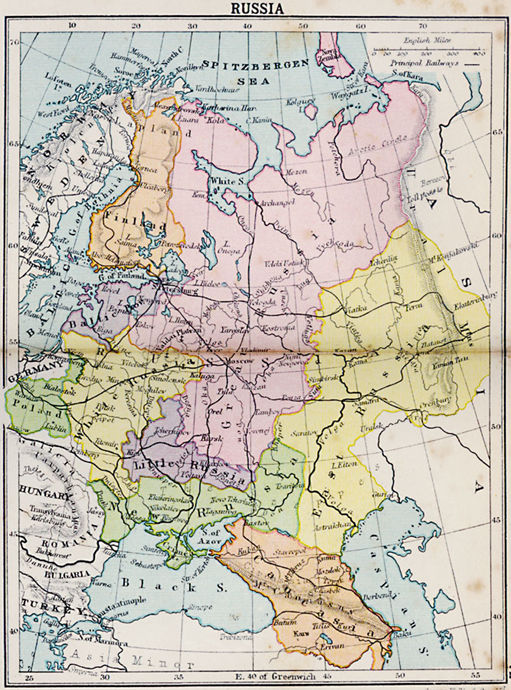
D.
In Russia, WWI exacted horrible price, led to food
riots, forcing Tsar to abdicate. Kerensky’s provisional
government acted slowly, was overthrown by
Bolsheviks with little fighting in November 1917.
The
Soviet Union (1989)
E.
In
Treaty of Versailles,
1919, regions of Habsburg empire ceded to Serbian, Czech, and
Polish control.
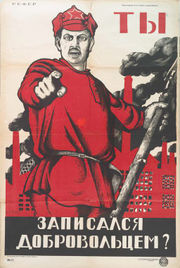
Russian Civil War Poster
"Have you signed up as a volunteer?"
VI.
War Communism (1918-1921)
A.
New Bolshevik leaders faced problems.
1.
Promise of socialism.
2.
Consolidation of Bolshevik rule.
3.
Allied invasion after 1918 Brest-Litovsk Treaty
B.
Provisions of War
Communism
1.
Confiscation of private and church land without
compensation.
2.
Forcibly extracted "surpluses" from agricultural workers.
3.
Goods and food rationed, private trade outlawed.
4.
Most industrial enterprises nationalized and administered by
commissariats headed by Vesenkha.
5.
"Labor armies" rebuilt roads and railways, and worked in
mines.
C.
Performance—Production plummeted, arising from
poor work incentives, concealment of surpluses, and chaotic
management, but also from wartime disruption.
VII.
The New Economic Policy (1921-1928)
A.
Design—a temporary experiment in market socialism
1.
Progressive agricultural tax.
2.
Private trade was legalized.
3.
Small enterprises leased to entrepreneurs and larger
enterprises operated as public trusts. Only "the
commanding heights of industry" were kept under direct
governmental control.
4.
Freer labor mobility, market-determined wages, and pro-labor
legislation.
B.
Performance—After 1921, NEP supported rapid recovery, but with
rising inequality.
VIII.
The Industrialization Debate
A.
Stimulated by the Scissors Crisis and Lenin's
death in 1924.
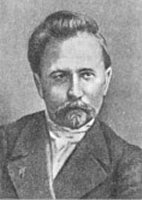
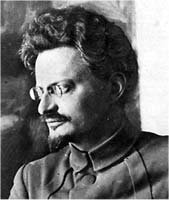
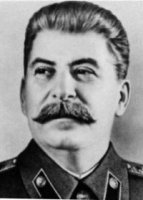

Yevgeny
Preobrazhensky
Lev
Trotsky
Joseph
Stalin
Nikolai
Bukharin
B.
Bukharin and "right-deviation" faction:
1.
Continuation of the market-oriented policies of NEP, following
comparative advantage in agriculture.
2.
Maintain smychka, or alliance,
between agricultural and industrial workers.
3.
Agricultural investments in the short run would most
effectively support industrial development in the long run.
C.
Trotsky, Preobrazhensky, and “left-deviation" faction:
1.
NEP will lead to return of capitalism
2.
USSR, surrounded by enemies, needs heavy industry.
3.
Industrialization accelerated by exploitation of the private
sector and agriculture.
D.
Worldwide socialist revolution versus socialism in one
country.
E.
Planning debate—Geneticists
versus
teleologists.
IX.
The Planning Era Begins (1929-1945)
A.
After vacillation, Stalin adopted a leftist and teleological
strategy. The First Five-Year Plan called for rapid rates
growth of all sectors, but highest for producer goods and
lowest for agriculture. Fulfillment of the plan was even more
leftist.
B.
Falling agricultural production caused by low plan priority
and violent collectivization. Industrialization strengthened
the nation’s military stance, but eventually turned a major
grain exporter into an importer.
X. After World War II (1945-1953)
A.
From “capitalist encirclement,” and Soviet autarky, to the
“socialist commonwealth.”
1.
Adoption of Soviet-style systems throughout region.
2.
Creation of Council
for Mutual Economic Assistance
to answer the Marshall Plan. Redirection of trade.
3.
East German, Romanian, and Hungarian reparations to USSR.
B.
Tito's Yugoslavia
1.
Impact of WWII.
2.
Tito’s hero status.
3.
Initial acceptance of Soviet political/economic system.
4.
Conflicts with Stalin, 1948 expulsion from Comintern.
5.
Reversal in 1950—acceptance of Western aid and adoption
of labor self-management.
XI.
After Stalin (1953-1960)
1953
Stalin's death in 1953
1956
Khrushchev's denunciation of Stalin's terror
Albanian
schism
Hungarian
revolt crushed by Soviet troops
Upgrading
of CMEA
1962
Basic
Principles of the International Socialist Division of Labor
called for specialization and integration of production.
Khrushchev’s
abortive attempt to introduce supranational planning.
XII.
Early Reforms (1960-1970)
A.
Soviet system inappropriate for small, trade-dependent
countries. Hungary and Poland initiated reforms.
B.
Deterioration of Soviet growth. Kosygin reforms of mid-1960s.
C.
Watershed in 1968— Prague Spring and Hungarian New Economic
Mechanism.
XIII.
Prelude to the Fall (1970-1985)
1970
Food price hikes in Poland lead to strikes, repression, and
resignation of Gomulka.
1972
Nixon visits Moscow, launches détente.
1976
Polish indebtedness culminates again in price hikes, strikes,
repression.
1978
Selection of Polish pope.
1980
Birth of Solidarity trade union in Poland.
1981
Polish martial law.
XIV.
The End and the New Beginning (1985-1991)
1985
Mikhail Gorbachev takes office in the Soviet Union, introduces
glasnost (openness) and perestroika
(restructuring), and repudiates Brezhnev Doctrine.
1989
Mass demonstrations, destruction of Berlin Wall, removal of
Communist leaders throughout the region.
1990
Balcerowicz “shock therapy” in Poland.
1991
Abortive coup against Gorbachev causes Russian President
Yeltsin to suspend Communist Party activities and Gorbachev to
dissolve USSR.
|